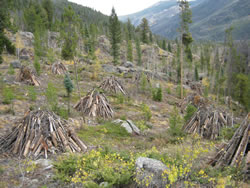National Cohesive Wildland Fire Management Strategy Success Story
Pile Burning at Rocky Mountain National Park
Rocky Mountain National Park, Colorado
Cohesive Strategy – Fire-Adapted Human Communities
2012

A few of the many piles that were burned during the winter of 2011-12. NPS photo.
The fire management program at Rocky Mountain National Park has planned and implemented many successful fuel reduction projects since the early 1980s with the intent of reducing the amount of burnable vegetation near values at risk, both private and public. These fuel reduction projects have also helped to maintain natural, ecological processes, restore and maintain fire adapted ecosystems and reduce the risks from wildfires in the park.
These successful fuel reduction projects involved burning a significant number of debris piles during the winter of 2011-2012, which treated 497 acres of hazardous fuels in high-risk areas of the park adjacent to communities. A total of 5,681 large piles were burned as conditions allowed. The piles had been created from various fuel reduction efforts where debris from thinned and limbed trees and dead, woody material on the forest floor were made into piles. The piles were then burned in place during the winter when conditions were wet from either rain or snow, thus limiting their spread into adjacent vegetation. In addition, the piles were only burned under weather conditions that allowed for adequate smoke dispersal. A burn permit was required from the Colorado Department of Public Health and Environment’s Air Pollution Control Division that detailed the constraints under which the piles could be burned.
One of the greatest successes this project achieved was the safety record. There were no lost time injuries during this complex fuel reduction project. This was by no way either accident or luck. Due to the high experience level of this year’s fire crew, they knew well that there were potential hazards, but placed safety over production. They came up with new and additional methods, procedures and mitigations to reduce the possibility of injuries occurring. Even though all NPS Fire and Aviation Management Programs stress the importance of safety in fire related projects, it is still an inherently risk-associated endeavor. It is a credit to the leadership and staff of Rocky Mountain NP that such a large scale fuel reduction project was successfully completed without an injury.
The goal of Rocky Mountain’s Fire Management Program is to protect people and values such as employees, neighbors, visitors, communities, infrastructure and natural and cultural resources. The policy of using fire as a tool will help decrease risks to life, property and resources and help perpetuate the values for which this national park was established.
Contact: Mike Lewelling, Fire Management Officer, 970-586-1287, mike_lewelling@nps.gov